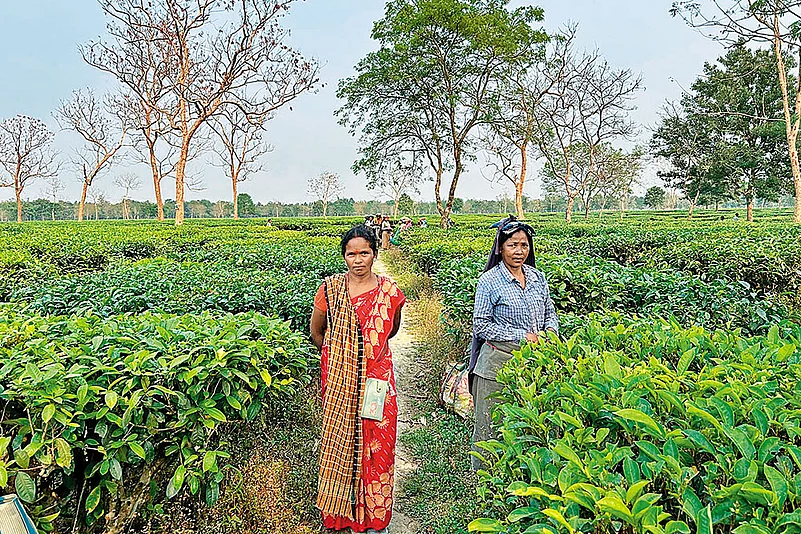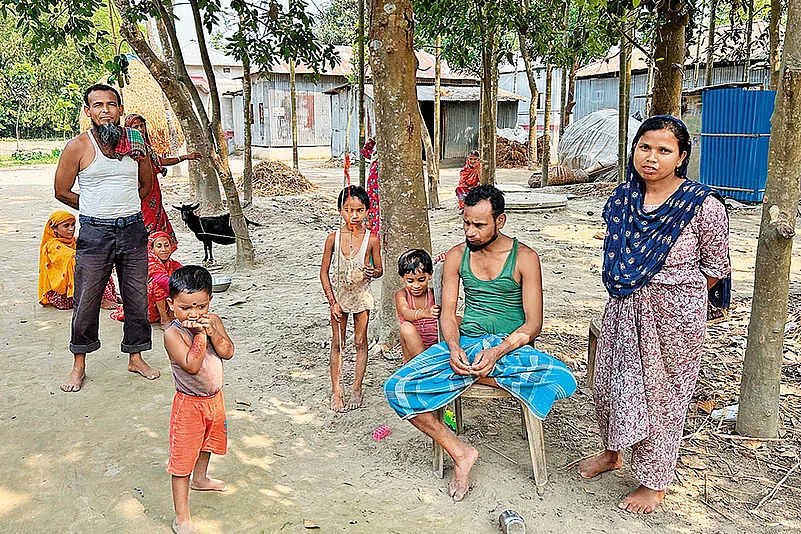The waters of Torsha cradling the planned city of Cooch Behar have a royal story to tell. Like the rest of Bengal, the summers have a deep impact on the district—the diminishing river and dry loo blowing across the bustling heritage town was proof that summer had officially set in.
On the outskirts of the city, for miles, there is soothing lush greenery, with little huts and settlements dotting the buffer zones between fields. To the north of Cooch Behar lies Alipurduar, bordering Bhutan—the two share the floodplains of the Western Dooars, and the violent politics of the Himalayan foothills.
As the Lok Sabha elections approach, the situation in these districts, which were preparing to go to polls in the first phase on April 19, somewhat mirrors the flags in the same hole. Only here, both try to jostle past each other in brute displays of power, wooing strategies and claiming the headlines of the constituencies grappling with a contrast of noise and deafening silence.
The Rajbanshi Sway
Bijoy, a driver by profession, believes the town used to be a peaceful place, with a sizeable influx of tourists all through the year. However, things have taken a hit following the pandemic. When asked about the poll buzz, he says while staring at the festoons and posters colouring the wall: “The TMC goons capture booths and do not allow people to vote, while the BJP is after driving people away from the land.”
Over the last few years, Cooch Behar has been home to heated political exchanges. Once under the royal Koch dynasty, the seat was a Left Front bastion under the Forward Bloc from independence until 2014, when the TMC gained ground and swept the seat for the first time in the Lok Sabha elections.
In the 2019 Lok Sabha elections, turncoat BJP leader Nisith Pramanik won the seat and ever since it has been recognised as a saffron stronghold in the state. The performance was repeated in the 2021 West Bengal Assembly elections where the BJP won five out of seven seats in the district. “The TMC desperately wants to come back to power in Cooch Behar. We can feel it. And the BJP doesn’t want to let it go, but I don’t think either party understands the problems plaguing us,” Bijoy affirms.

A seat reserved for the Scheduled Castes (SC), Cooch Behar’s politics has been defined by the sway of the Rajbanshi community—the largest SC group in the state who constitute around 40 per cent of the vote bank.
Ten days before the polls, the Rashmela Maidan was bathed in a sea of yellow gamchas with green borders—colours which represent the community. Thousands of Rajbanshi people had gathered to hear Banshi Badan Barman, a noted leader of the Greater Cooch Behar Movement. He had come out in support of Jagadish Chandra Basunia, a sitting MLA— the TMC’s trusted Rajbanshi face and the Lok Sabha candidate.
“We have not received anything from the BJP government here. Mamata Banerjee has helped us in our momentum for development, recognition and has provided support to our community, and it is with her support our Rajbanshi pride will be recognised under the Eighth Schedule of the constitution,” said Barma, riling up the crowd in the scorching heat.
In 2019, a major portion of the community had rallied behind Pramanik, the BJP candidate and a Rajbanshi face, now a minister in the Ministry of Home Affairs. The BJP continues to woo the community by developing its intimacy with another noted Rajbanshi leader Ananta Rai, a self-proclaimed descendant of the royal family. However, recently he has distanced himself from the party with a brewing sense of dissatisfaction making news as the BJP reappointed Pramanik as the MP candidate.
In the 2019 Lok Sabha elections, turncoat BJP leader Nisith Pramanik won the seat and ever since it has been recognised as a saffron stronghold in the state.
When Mamata addressed a gathering in Dinhata, around fifty km from Cooch Behar, two days later, there was a sense of emotional appeal in her voice, coupled with hubris. “Who set up the Rajbanshi Bhasha Academy? I did. The Rajbanshi Development and Cultural Board, the Panchanan Barma University, and around 200 Rajbanshi schools? I did. The statue of Chilarai? I did. Then why will they get the votes?” she asked as a packed Sanghati Maidan in Dinhata roared in acceptance. The front rows at the gathering were mostly women from the Rajbanshi and other marginalised communities.
For a major portion of Rajbanshi women, Mamata’s welfare schemes have worked like a magic potion. For instance, under the Lakshmi Bhandar scheme, which provides financial assistance to women from economically weaker sections of society, women from SC/ST households receive Rs 1,000 every month and others, Rs 500.
Lakshmi Bhandar has become a buzzword for women across the district. “I feel proud that I receive Rs 1,000 every month. It makes me feel powerful that I can support my family with money from my account,” says a woman in the crowd. On the other hand, a section complains about the scheme not reaching them and blames the TMC for making lapses a norm across the district.
“The BJP has been a constant since the days of Left oppression in the district. We have guaranteed a Cooch Behar free from TMC-sponsored corruption, safe for women and benefitted from the upliftment of our Rajbanshi brothers and sisters. The reason why we are still in power,” says Sukumar Roy, the BJP district president.
Streak of Violence
Political repartee is a common element in Cooch Behar politics. While for the BJP, it is about holding on to the bastion this time around, TMCs leaders are desperate to snatch it back from the Opposition. The tension is palpable on the ground, with numerous instances of violence recorded across the constituency in the prelude to the polls.
When asked about the seat being associated with a reign of terror, Udayan Guha, minister in charge, North Bengal Development Department, and the son of former popular Forward Bloc leader Kamal Guha, says: “There is no terror here. It is a peaceful place but since Nisith Pramanik, a person who doesn’t even belong here and one against whom there are so many cases of trafficking, robbery and what not, has come to power here, it is obvious why he would like to induce panic amongst the people. It is all about optics.”
The leaders distance themselves from the violence in Cooch Behar with their fingers always pointed at each other. However, it is the very grassroots of the district that continues to deal with the shockwaves of the incidents.
Around 60 km from Cooch Behar town lies Sitalkuchi, the very place which had seen four youths—Maniruzzaman Rahman, Noor Alam, Samiul Haque and Hamidul Miya—being killed in CISF firing during the 2021 West Bengal assembly elections.
Sixty km to the northeast of Cooch Behar, Across the Alipurduar district, the Adivasi community continues to wrestle with poverty and casteism every passing day.
Tucked away in a silent village with a Muslim-majority population, this part of Sitalkuchi has been having heartbreakingly silent Eid celebrations over the last couple of years. Amzad Hossain and Mamata Bibi, the ailing parents of the deceased Maniruzzaman, find it difficult to manage two proper meals in a day. “The sound of the bullets rings in my ears every day ... the image of watching life escape the bloodied body of my boy. They promised so many things and delivered nothing. We are left to deal with our own memories,” says Amzad.
The locals believe that the Sitalkuchi incident has been milked by both parties to throw shade at each other and build flaky electoral promises. “They promise, they take the votes, they leave,” says Fajli Bibi, Azad’s sister and neighbour. Maniruzzaman’s wife has severed all ties with the family after taking the money, offered by the government, leaving the ailing parents to fend for themselves.
“Mani used to hold a feast every year on Eid with all locals. Since he has left us, Eid is the most difficult day of the year. Let alone new clothes, we do not have the means to afford the medicines and necessary food during Ramazan,” uttered a teary-eyed Mamata Bibi from the darkness of the room.
Promises have fallen loose in this village of Sitalkuchi. Noor Alam’s sister was offered a job as a labourer in places miles away from the village, where she is needed to take care of her three-year-old child. “It is not possible for a woman to travel so many miles, work, come back, cook, and take care of her child. They offer these jobs as consolation, knowing very well that it would not be possible for us to consider these,” says Noor Alam’s father.
Inside The Estates
Sixty km to the northeast of Cooch Behar city lies the Majher Dabri tea estate of Alipurduar. Down an unassuming lane is a settlement and labour line of around 66 families, which is known as the Asur line. The Adivasi tea estate workers believe they are the direct descendants of the demon and warrior king Mahishasur. They refuse to believe in the Hindu tradition of worshipping Goddess Durga as the destroyer of evil and reject the consideration of Mahishasur as a signifier of evil.
A majority of the women in these households work in the tea plantations, earning a meagre amount of Rs 250 per day, while the men take up work as a carpenter, cleaner or security guard whenever something crops up.
Across the district, the Adivasi community continues to wrestle with poverty and casteism every passing day. “What do we do with Rs 250? Buy the necessary things, send our daughters to the city, marry our son off, buy medicines, apply a hundred times for our caste certificate and what else? We are not allowed to enter offices, turned away most of the time,” says Kalyan Beng, a sixty-year-old local from the Asur Line. “But amidst all these, Didi gives us hope. She at least recognises us and helps our families with Lakshmi Bhandar.”
Ram Kumar Toppo, who used to be the head of the local panchayat, believes Mamata and the party have worked for the Adivasis. “Whoever comes to power, I hope they increase the daily wage in the estates and give us permanent houses as soon as possible.” Beng nodded in agreement, as he went back to his usual noon-time hariya—local wine made by fermenting rice.
Alipurduar, a reserved Scheduled Tribes (ST) seat, has seen its contours shaped by Adivasi politics around tea plantations. The workers continue to tackle a lack of facilities, proper sanitation, and infrastructural inadequacy, in addition to the BSF not allowing them to access the forests for gathering wood and essentials.
Hana Tirkey, who has been working in the Mathura Tea Estate for twenty years, is tired of leaders turning up just before elections to throw fake promises. “We don’t have proper roads and it becomes very difficult during monsoons. Work here takes an immense physical toll, and with the lack of good doctors and medicines, it becomes more difficult,” she says. Half of the estate workers are yet to receive their caste certificates despite multiple online applications.
“None of us has received houses under the Pradhan Mantri Awas Yojana. Many here don’t receive Lakshmi Bhandar money. I trust Didi, but she should ensure that we get our houses and good medicines.” While the BJP and Trinamool battle it on the surface in a game of strongholds, the Himalayan foothills of West Bengal conspire to accommodate a tricky paradox— of noise and silence in the grassroots.
Agnideb Bandyopadhyay in Cooch Behar and Alipurduar
This appeared in the print as 'The Stained Floodplains'


















